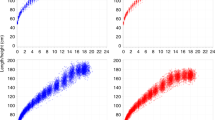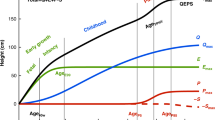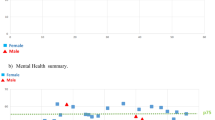Abstract
Background
Over the past 150 years, humans have become taller, and puberty has begun earlier. It is unclear if these changes are continuing in Sweden, and how longitudinal growth patterns are involved. We aimed to evaluate the underlying changes in growth patterns from birth to adulthood by QEPS estimates in two Swedish cohorts born in 1974 and 1990.
Methods
Growth characteristics of the longitudinal 1974 and 1990-birth cohorts (n = 4181) were compared using the QEPS model together with adult heights.
Results
There was more rapid fetal/infancy growth in girls/boys born in 1990 compared to 1974, as shown by a faster Etimescale and they were heavier at birth. The laterborn were taller also in childhood as shown by a higher Q-function. Girls born in 1990 had earlier and more pronounced growth during puberty than girls born in 1974. Individuals in the 1990 cohort attained greater adult heights than those in the 1974 cohort; 6 mm taller for females and 10 mm for males.
Conclusion
A positive change in adult height was attributed to more growth during childhood in both sexes and during puberty for girls. The QEPS model proved to be effective detecting small changes of growth patterns, between two longitudinal growth cohorts born only 16 years apart.
Similar content being viewed by others
Log in or create a free account to read this content
Gain free access to this article, as well as selected content from this journal and more on nature.com
or
References
Bogin, B. Evolutionary perspective on human growth. Annu. Rev. Anthropol. 28, 109–153 (1999).
Tanner, J. M. Growth as a mirror of the condition of society: secular trends and class distinctions. Acta Paediatr. 29, 96–103 (1987).
Cole T. J., Mori H. Fifty years of child height and weight in Japan and South Korea: contrasting secular trend patterns analyzed by SITAR. Am. J. Hum. Biol. 30 (2018).
Hochberg, Z. & Albertsson-Wikland, K. Evo-Devo of infantile and childhood growth. Pediatr. Res. 64, 2–7 (2008).
Gelander, L. Children’s growth: a health indicator and a diagnostic tool. Acta Paediatr. 95, 517–518 (2006).
Monteiro, P. O. & Victora, C. G. Rapid growth in infancy and childhood and obesity in later life–a systematic review. Obes. Rev. 6, 143–154 (2005).
Eriksson, J. G., Forsen, T. J., Kajantie, E., Osmond, C. & Barker, D. J. Childhood growth and hypertension in later life. Hypertension 49, 1415–1421 (2007).
Kindblom, J. M. et al. Pubertal timing is an independent predictor of central adiposity in young adult males: the Gothenburg osteoporosis and obesity determinants study. Diabetes 55, 3047–3052 (2006).
Parent, A. S. et al. The timing of normal puberty and the age limits of sexual precocity: variations around the world, secular trends, and changes after migration. Endocr. Rev. 24, 668–693 (2003).
Hatton, T. J. & Bray, B. E. Long run trends in the heights of European men, 19th–20th centuries. Econ. Human. Biol. 8, 405–413 (2010).
Liu, Y. X., Albertsson-Wikland, K. & Karlberg, J. New reference for the age at childhood onset of growth and secular trend in the timing of puberty in Swedish. Acta Paediatr. 89, 637–643 (2000).
Cernerud, L. & Lindgren, G. W. Secular changes in height and weight of Stockholm schoolchildren born in 1933, 1943, 1953 and 1963. Ann. Human. Biol. 18, 497–505 (1991).
Tanner, J. M. Growth as a monitor of nutritional status. Proc. Nutr. Soc. 35, 315–322 (1976).
Karlberg, J. Secular trends in pubertal development. Horm. Res. 57(Suppl 2), 19–30 (2002).
Fredriks, A. M. et al. Continuing positive secular growth change in The Netherlands 1955–1997. Pediatr. Res. 47, 316–323 (2000).
Schonbeck, Y. et al. The world’s tallest nation has stopped growing taller: the height of Dutch children from 1955 to 2009. Pediatr. Res. 73, 371–377 (2013).
Lissner, L. et al. Secular trends in weight, height and BMI in young Swedes: The ‘Grow up Gothenburg’ Studies. Acta Paediatr. 102, 314–317 (2013).
Karlberg, J. A biologically-oriented mathematical model (ICP) for human growth. Acta Paediatr. Scand. 350, 70–94 (1989).
Nierop, A. F. et al. Modelling individual longitudinal human growth from fetal to adult life - QEPS I. J. Theor. Biol. 406, 143–165 (2016).
Holmgren, A. et al. Insight into human pubertal growth by applying the QEPS growth model. BMC Pediatr. 17, 107 (2017).
Albertsson-Wikland, K., Luo, Z. C., Niklasson, A. & Karlberg, J. Swedish population-based longitudinal reference values from birth to 18 years of age for height, weight and head circumference. Acta Paediatr. 91, 739–754 (2002).
Sjöberg, A. et al. Body size and lifestyle in an urban population entering adulthood: the ‘Grow up Gothenburg’ Study. Acta Paediatr. 101, 964–972 (2012).
Holmgren A., et al. Pubertal height gain is inversely related to peak BMI in childhood. Pediatr. Res. (2017).
Welfare NBoHa (2015).
Silventoinen, K. Determinants of variation in adult body height. J. Biosoc. Sci. 35, 263–285 (2003).
Odlind, V., Haglund, B., Pakkanen, M. & Otterblad Olausson, P. Deliveries, mothers and newborn infants in Sweden, 1973–2000. Trends in obstetrics as reported to the Swedish Medical Birth Register. Acta Obstet. Et. Gynecol. Scand. 82, 516–528 (2003).
Karlberg, J. & Luo, Z. C. Foetal size to final height. Acta Paediatr. 89, 632–636 (2000).
Skjaerven, R., Gjessing, H. K. & Bakketeig, L. S. Birthweight by gestational age in Norway. Acta Obstet. Et. Gynecol. Scand. 79, 440–449 (2000).
Schack-Nielsen, L., Molgaard, C., Sorensen, T. I., Greisen, G. & Michaelsen, K. F. Secular change in size at birth from 1973 to 2003: national data from Denmark. Obesity 14, 1257–1263 (2006).
Saari, A. et al. New Finnish growth references for children and adolescents aged 0 to 20 years: Length/height-for-age, weight-for-length/height, and body mass index-for-age. Ann. Med. 43, 235–248 (2011).
Tinggaard, J. et al. The 2014 Danish references from birth to 20 years for height, weight and body mass index. Acta Paediatr. 103, 214–224 (2014).
Xu, X., Wang, W. P., Guo, Z. P., Cheung, Y. B. & Karlberg, J. P. Secular change in growth over one decade (1980–1990) in Shanghai infants. J. Pediatr. Endocrinol. Metab. 13, 1603–1614 (2000).
Liu, Y. X., Jalil, F. & Karlberg, J. Growth stunting in early life in relation to the onset of the childhood component of growth. J. Pediatr. Endocrinol. Metab. 11, 247–260 (1998).
Liu, Y., Albertsson-Wikland, K. & Karlberg, J. Long-term consequences of early linear growth retardation (stunting) in Swedish children. Pediatr. Res. 47(4 Pt 1), 475–480 (2000).
Juliusson, P. B. et al. Growth references for 0–19 year-old Norwegian children for length/height, weight, body mass index and head circumference. Ann. Human. Biol. 40, 220–227 (2013).
Di Giovanni, I. et al. Being born large for gestational age is associated with earlier pubertal take-off and longer growth duration: a longitudinal study. Acta Paediatr. 106, 61–66 (2017).
Juul, A. et al. Pubertal development in Danish children: comparison of recent European and US data. Int. J. Androl. 29, 247–255 (2006).
Papadimitriou, A. et al. Pubertal maturation of contemporary Greek boys: no evidence of a secular trend. J. Adolesc. Health.: Off. Publ. Soc. Adolesc. Med. 49, 434–436 (2011).
Aksglaede, L., Olsen, L. W., Sorensen, T. I. & Juul, A. Forty years trends in timing of pubertal growth spurt in 157,000 Danish school children. PLoS ONE 3, e2728 (2008).
Roelants, M., Hauspie, R. & Hoppenbrouwers, K. References for growth and pubertal development from birth to 21 years in Flanders, Belgium. Ann. Human. Biol. 36, 680–694 (2009).
Acknowledgements
We thank all the staff and students of the participating schools and the study team for the collection, and computerizing of the original data. Thanks for valuable editing and language revision to Harriet Crofts. The authors acknowledge financial support from the Swedish Research Council (7509 and VR 2006-7777); the Swedish Council Formas (259-2012-32); the Swedish Research Council for Working Life and Social Research (2006-1624); Pfizer AB; the Governmental Grants for University Hospital Research (ALF) from Region Västra Götaland; PhD grants from the Southern Swedish healthcare region; the R&D department, County of Halland; and the Foundation Växthuset for children.
Author information
Authors and Affiliations
Corresponding author
Ethics declarations
Competing interests
A.F.M.N. works for Muvara, Multivariate Analysis of Research Data, Statistical Consultation, the Netherlands. the remaining authors declare no competing interests.
Additional information
Publisher's note: Springer Nature remains neutral with regard to jurisdictional claims in published maps and institutional affiliations.
Electronic supplementary material
Rights and permissions
About this article
Cite this article
Holmgren, A., Niklasson, A., Nierop, A.F.M. et al. Estimating secular changes in longitudinal growth patterns underlying adult height with the QEPS model: the Grow Up Gothenburg cohorts. Pediatr Res 84, 41–49 (2018). https://doi.org/10.1038/s41390-018-0014-z
Received:
Accepted:
Published:
Issue date:
DOI: https://doi.org/10.1038/s41390-018-0014-z
This article is cited by
-
Growth pattern evaluation of the Edinburgh and Gothenburg cohorts by QEPS height model
Pediatric Research (2022)
-
Novel type of references for weight aligned for onset of puberty – using the QEPS growth model
BMC Pediatrics (2021)



